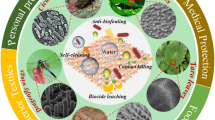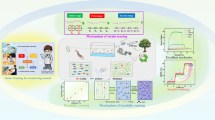Abstract
Fabric surface coating is deemed as the major route to fabricate functional fabrics, and interface stability is a critical factor affecting the performance of fabric. Here, electrophoretic deposition (EPD) is employed for fast and facile modification of hydrophobic polyamide fabric with graphene oxide (GO) nanosheets embedded in polymeric networks. For better grafting, polyethyleneimine is utilized to modify the surface of the fabric substrate, endowing more polar groups and resulting in reasonable interface properties of graphene oxide and fabric substrate. GO nanosheets are uniformly deposited on modified fabric via EPD method and then reduced by green hot-press processing. The modified fabric shows excellent electrical conductivity (electrical conductivity > 3.3 S/m), thermal conductivity (0.521 W/m·K), and UV protection performance (UPF > 500, UVA < 0.2%). Meanwhile, the contact angle test of fabric reveals that the addition of graphene significantly improved the hydrophobicity of the fabric.













Similar content being viewed by others
References
Tian M, Tang X, Qu L, Zhu S, Guo X, Han G (2015) Robust ultraviolet blocking cotton fabric modified with chitosan/graphene nanocomposites. Mater Lett 145:340–343
Tian M, Hu X, Qu L, Zhu S, Sun Y, Han G (2016) Versatile and ductile cotton fabric achieved via layer-by-layer self-assembly by consecutive adsorption of graphene doped PEDOT: PSS and chitosan. Carbon 96:1166–1174
Tian M, Du M, Qu L, Zhang K, Li H, Zhu S et al (2016) Conductive reduced graphene oxide/MnO2 carbonized cotton fabrics with enhanced electro -chemical, -heating, and -mechanical properties. J Power Sources 326:428–437
Ren J, Wang C, Zhang X, Carey T, Chen K, Yin Y et al (2017) Environmentally-friendly conductive cotton fabric as flexible strain sensor based on hot press reduced graphene oxide. Carbon 111:622–630
Corni I, Ryan MP, Boccaccini AR (2008) Electrophoretic deposition: from traditional ceramics to nanotechnology. J Eur Ceram Soc 28(7):1353–1367
Besra L, Liu M (2007) Prog Mater Sci 52(1):1–61
Sato N, Kawachi M, Noto K, Yoshimoto N, Yoshizawa M (2001) Effect of particle size reduction on crack formation in electrophoretically deposited YBCO films. Phys C 357:1019–1022
Kumar N, Yu YC, Lu YH et al (2015) Fabrication of carbon nanotube/cobalt oxide nanocomposites via electrophoretic deposition for supercapacitor electrodes. J Mater Sci 51(5):2320–2329. https://doi.org/10.1007/s10853-015-9540-9
Ghasemi S, Jafari M, Ahmadi F (2016) Cu2O-Cu(OH)(2)-graphene nanohybrid as new capacitive material for high performance supercapacitor. Electrochim Acta 210:225–235
Wang M, Duong LD, Nguyen Thi M, Kim S, Kim Y, Seo H et al (2015) All-solid-state reduced graphene oxide supercapacitor with large volumetric capacitance and ultralong stability prepared by electrophoretic deposition method. ACS Appl Mater Interfaces 7(2):1348–1354
Ghasemi S, Ahmadi F (2015) Effect of surfactant on the electrochemical performance of graphene/iron oxide electrode for supercapacitor. J Power Sources 289:129–137
Kim S, Oh J-S, Kim M-G, Jang W, Wang M, Kim Y et al (2014) Electromagnetic interference (EMI) transparent shielding of reduced graphene oxide (RGO) interleaved structure fabricated by electrophoretic deposition. ACS Appl Mater Interfaces 6(20):17647–17653
Wang M, Le Dai D, Oh J-S, Nguyen Thi M, Kim S, Hong S et al (2014) Large-area, conductive and flexible reduced graphene oxide (RGO) membrane fabricated by electrophoretic deposition (EPD). ACS Appl Mater Interfaces 6(3):1747–1753
Hamadanian M, Zolfaghari AR (2012) Modified multistep electrophoretic deposition of TiO2 nanoparticles to prepare high quality thin films for dye-sensitized solar cell. J Mater Sci 47(15):5845–5851. https://doi.org/10.1007/s10853-012-6484-1
Luan X, Chen L, Zhang J, Qu G, Flake JC, Wang Y (2013) Electrophoretic deposition of reduced graphene oxide nanosheets on TiO2 nanotube arrays for dye-sensitized solar cells. Electrochim Acta 111:216–222
Kollath VO, Chen Q, Mullens S et al (2016) Electrophoretic deposition of hydroxyapatite and hydroxyapatite–alginate on rapid prototyped 3D Ti6Al4V scaffolds. J Mater Sci 51(5):2338–2346. https://doi.org/10.1007/s10853-015-9543-6
Jankovic A, Erakovic S, Mitric M, Matic IZ, Juranic ZD, Tsui GCP et al (2015) Bioactive hydroxyapatite/graphene composite coating and its corrosion stability in simulated body fluid. J Alloy Compd 624:148–157
Jankovic A, Erakovic S, Vukasinovic-Sekulic M, Miskovic-Stankovic V, Park SJ, Rhee KY (2015) Graphene-based antibacterial composite coatings electrodeposited on titanium for biomedical applications. Prog Org Coat 83:1–10
Maaoui H, Singh SK, Teodorescu F, Coffinier Y, Barras A, Chtourou R et al (2017) Copper oxide supported on three-dimensional ammonia-doped porous reduced graphene oxide prepared through electrophoretic deposition for non-enzymatic glucose sensing. Electrochim Acta 224:346–354
Belkhalfa H, Teodorescu F, Queniat G, Coffinier Y, Dokhan N, Sam S et al (2016) Insulin impregnated reduced graphene oxide/Ni(OH)(2) thin films for electrochemical insulin release and glucose sensing. Sens Actuators B-Chem 237:693–701
He L, Wang Q, Mandler D, Li M, Boukherroub R, Szunerits S (2016) Detection of folic acid protein in human serum using reduced graphene oxide electrodes modified by folic-acid. Biosens Bioelectron 75:389–395
Chen L, He H, Lei D, Menggen Q, Hu L, Yang D (2013) Field emission performance enhancement of Au nanoparticles doped graphene emitters. Appl Phys Lett 103(23):233105
Chen L, He H, Yu H, Cao Y, Lei D, Menggen Q et al (2014) Electron field emission characteristics of graphene/carbon nanotubes hybrid field emitter. J Alloy Compd 610:659–664
Kim T, Lee JS, Li K, Kang TJ, Kim YH (2016) High performance graphene foam emitter. Carbon 101:345–351
Joung YS, Buie CR (2015) Antiwetting fabric produced by a combination of layer-by-layer assembly and electrophoretic deposition of hydrophobic nanoparticles. ACS Appl Mater Interfaces 7(36):20100–20110
Tamrakar S, An Q, Thostenson ET, Rider AN, Haque BZ, Gillespie JW Jr (2016) tailoring interfacial properties by controlling carbon nanotube coating thickness on glass fibers using electrophoretic deposition. ACS Appl Mater Interfaces 8(2):1501–1510
An Q, Rider AN, Thostenson ET (2012) Electrophoretic deposition of carbon nanotubes onto carbon-fiber fabric for production of carbon/epoxy composites with improved mechanical properties. Carbon 50(11):4130–4143
Celik YC, Pulletikurthi G, Endres F (2016) Electrodeposition of Al, Zn, and Pt on silver-coated textile fibres from ionic liquids. J Solid State Electrochem 20(10):2781–2790
Molina J, Fernandez J, del Rio AI, Bonastre J, Cases F (2013) Chemical and electrochemical study of fabrics coated with reduced graphene oxide. Appl Surf Sci 279:46–54
Gorgieva S, Vogrinčič R, Kokol V (2015) Polydispersity and assembling phenomena of native and reactive dye-labelled nanocellulose. Cellulose 22(6):3541–3558
Zhang K, Zhang Y, Wang S (2013) Effectively decoupling electrical and thermal conductivity of polymer composites. Carbon 65:105–111
Zhang K, Wang S (2014) Thermal and electronic transport of semiconducting nanoparticle-functionalized carbon nanotubes. Carbon 69:46–54
ASTM D 1518-85 (1990) Standard test method for thermal transmittance of textile materials
AATCC Test Method 76-2005 (2010) Electrical surface resistivity of fabrics. AATCC Technical Manual 85:97
AATCC Test Method 183-2004 (2010) Transmittance or blocking of erythemally weighted ultraviolet radiation through fabrics. AATCC Technical Manual 85:318
Besra L, Liu M (2007) A review on fundamentals and applications of electrophoretic deposition (EPD). Prog Mater Sci 52(1):1–61
Zhitomirsky I, Galor L (1997) Electrophoretic deposition of hydroxyapatite. J Mater Sci Mater Med 8(4):213–219
Stankovich S, Dikin DA, Piner RD, Kohlhaas KA, Kleinhammes A, Jia Y et al (2007) Synthesis of graphene-based nanosheets via chemical reduction of exfoliated graphite oxide. Carbon 45(7):1558–1565
Mathesh M, Liu J, Nam ND, Lam SKH, Zheng R, Barrow CJ et al (2013) Facile synthesis of graphene oxide hybrids bridged by copper ions for increased conductivity. J Mater Chem C 1(18):3084–3090
Liu C, Yu Z, Neff D, Zhamu A, Jang BZ (2010) Graphene-based supercapacitor with an ultrahigh energy density. Nano Lett 10(12):4863
Tian M, Qu L, Zhang X, Zhang K, Zhu S, Guo X et al (2014) Enhanced mechanical and thermal properties of regenerated cellulose/graphene composite fibers. Carbohyd Polym 111:456–462
Wang X, Hu Y, Song L, Yang H, Xing W, Lu H (2011) In situ polymerization of graphene nanosheets and polyurethane with enhanced mechanical and thermal properties. J Mater Chem 21(12):4222–4227
Zhu Y, Stoller MD, Cai W, Velamakanni A, Piner RD, Chen D et al (2010) Exfoliation of graphite oxide in propylene carbonate and thermal reduction of the resulting graphene oxide platelets. ACS Nano 4(2):1227–1233
Tang H, Ehlert GJ, Lin Y, Sodano HA (2012) Highly efficient synthesis of graphene nanocomposites. Nano Lett 12(1):84–90
Waltman RJ, Pacansky J, Bates CW (1993) X-ray photoelectron spectroscopic studies on organic photoconductors: evaluation of atomic charges on chlorodiane blue and p-(diethylamino)benzaldehyde diphenylhydrazone. Chem Mater 5(12):1799–1804
Berger C (2006) Electronic confinement and coherence in patterned epitaxial graphene. Science 312(5777):1191
Elias DC, Nair RR, Mohiuddin TM, Morozov SV, Blake P, Halsall MP et al (2009) Control of graphene’s properties by reversible hydrogenation: evidence for graphane. Science 323(5914):610–613
Watcharotone S, Dikin DA, Stankovich S, Piner R, Jung I, Dommett GH, Nguyen ST (2007) Graphene-silica composite thin films as transparent conductors. Nano Lett 7(7):1888–1892
Balandin AA, Ghosh S, Bao W, Calizo I, Teweldebrhan D, Miao F et al (2008) Superior thermal conductivity of single-layer graphene. Nano Lett 8(3):902
Cai W, Piner RD, Stadermann FJ, Park S, Shaibat MA, Ishii Y et al (2008) Synthesis and solid-state nmr structural characterization of 13c-labeled graphite oxide. Science 321(5897):1815–1817
Zhang K, Zhang Y, Wang S (2013) Enhancing thermoelectric properties of organic composites through hierarchical nanostructures. Sci Rep 3:3448
Zhou T, Wang X, Cheng P, Wang T (2013) Improving the thermal conductivity of epoxy resin by the addition of a mixture of graphite nanoplatelets and silicon carbide microparticles. Express Polym Lett 7(7):585–594
Hu X, Tian M, Qu L, Zhu S, Han G (2015) Multifunctional cotton fabrics with graphene/polyurethane coatings with far-infrared emission, electrical conductivity, and ultraviolet-blocking properties. Carbon 95:625–633
Acik M, Lee G, Mattevi C, Chhowalla M, Cho K, Chabal YJ (2010) Unusual infrared-absorption mechanism in thermally reduced graphene oxide. Nat Mater 9(10):840–845
Acknowledgements
Financial support of this work was provided by Natural Science Foundation of China via Grant No. 51672141 and 51306095, China Postdoctoral Science Foundation via Grant No. 2014M561887 and 2015T80697, Shandong Province college science and technology Plan Project (J17KA030), Qingdao Postdoctoral Application Research Funded Project and Qingdao Application Basic Research Funded Project.
Author information
Authors and Affiliations
Corresponding authors
Rights and permissions
About this article
Cite this article
Zhao, H., Tian, M., Hao, Y. et al. Fast and facile graphene oxide grafting on hydrophobic polyamide fabric via electrophoretic deposition route. J Mater Sci 53, 9504–9520 (2018). https://doi.org/10.1007/s10853-018-2230-7
Received:
Accepted:
Published:
Issue Date:
DOI: https://doi.org/10.1007/s10853-018-2230-7




